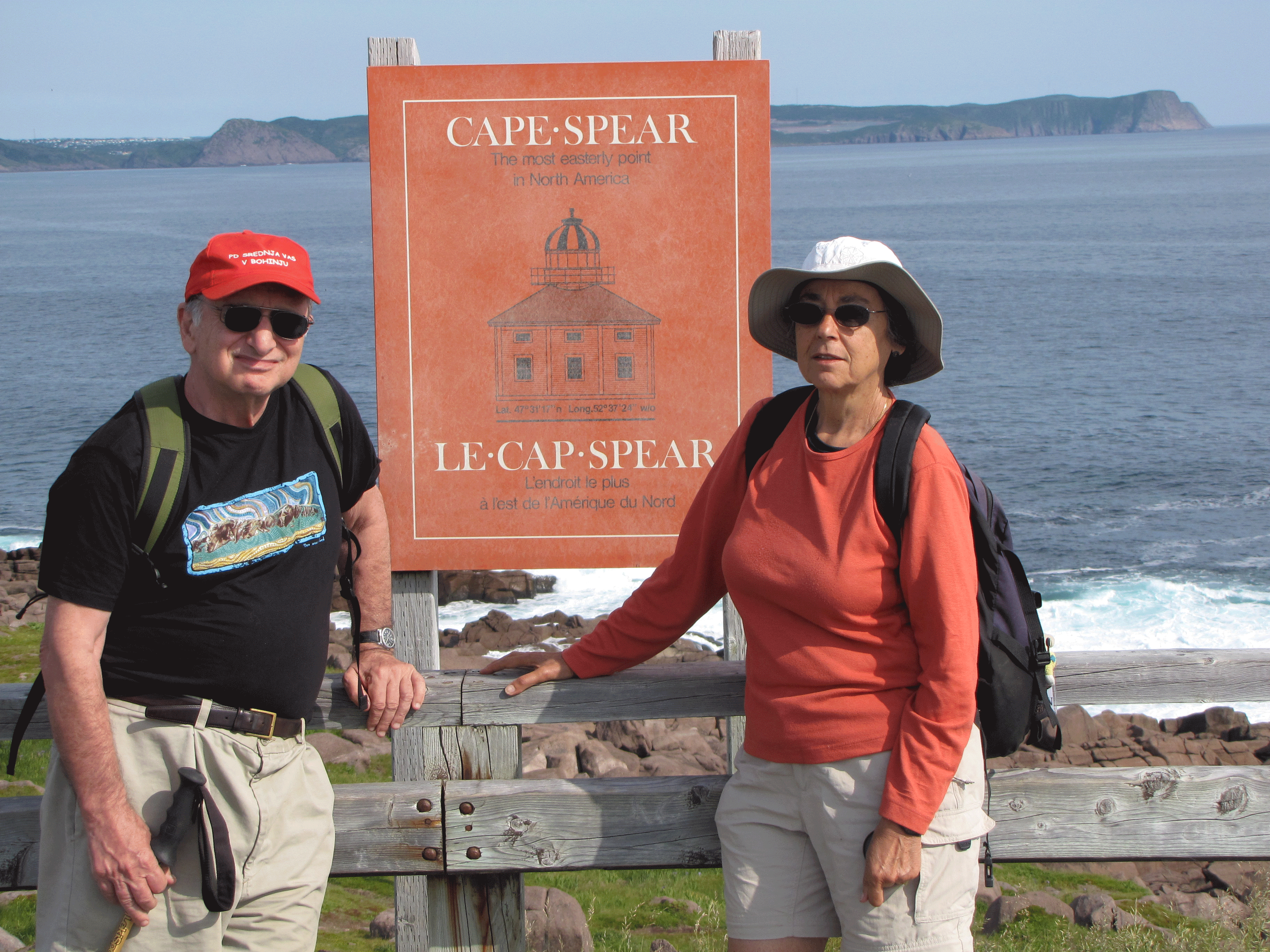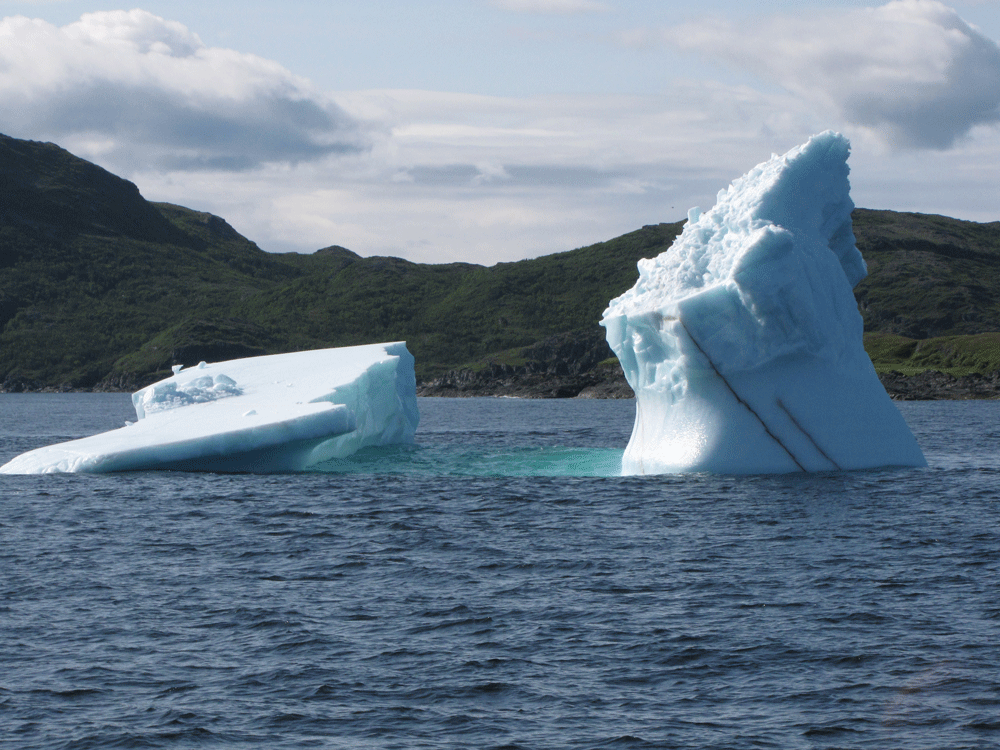It is a big Canadian island with not many people--about half a million. It became a part of Canada only in 1949, and then by the narrowest of margins among its voters. The largest (and only) city is the capital, St. John’s, population about 125,000. The largest runners-up have fewer than 25,000. The province is largely rural but not agricultural, as few crops grow in these northern climes. People live mostly around the coasts, where commercial fishing has been done for centuries. There are plenty of animals, including moose. Two mating pairs were imported from New Brunswick a century ago. Like the Cape Town penguins, they were very successful. There are now well over 100,000 of them. It is inadvisable to drive your car into one. They come out at dusk and are such a hazard that night driving is to be avoided. Moose are very big animals.

You can drive there from New York, but it’s more than 1000 miles: north of Nova Scotia and east of Quebec. We took the daily flight (Continental) from Newark to St. John’s. There we met the other ten members of our Sierra Club group, along with the two leaders. Most members were in their fifties or early sixties; we assumed our customary position as the eldest. Like our previous trips with the Club, this was very well organized. It was also quite civilized: we stayed in B & B’s and took dinner in restaurants. The only communal task was laying out food for box lunches.
The East Coast Trail is an unfinished track that will run for 137 miles along the Avalon Peninsula. It has few serious uphill sections, but bends to follow the numerous rocky ocean coves. We hiked every day of the week-long Club trip, with time out for kayaking and whale-watching from a Zodiac. The distances ranged from four miles (half days) to nine. We can heartily recommend the terrain to reasonably fit hikers. The trails are in excellent shape, with short sturdy bridges and long sections of wooden walkway to protect the fragile and boggy ground. Once we encountered a team of trail builders. They had been at work since April. They sought rocks to pound into gravel and spruce and juniper for the bridges and boardwalks. The terrain is forested, with open breaks that give great views, and is punctuated by dramatic coves. They can be precipitous. Stay on the trail. The Atlantic ocean is often in sight, and you can see dolphin and whales, especially humpbacks and Minke. Sunny weather required.
At the end of our Sierra Club trip, we checked into the Newfoundland Sheraton so that Susan could use its swimming pool. We congratulated ourselves on not having been an elderly embarrassment on the hike and on having had clear weather. This is definitely not the norm. A cabbie told us: “That was the first week of summer we’ve had in 20 years.” We were all set for a second week on our own.
It was then that we realized that we could not find our passports.
What to do in Newfoundland when you have lost your passports:
First, reflect that if this had only happened before the new regulations of June 1st, it wouldn’t have mattered.
Next, contact in vain all the places where the passports might have slipped out and check the places where you have stayed, likewise without success.
Then phone the nearest consulate, which is in Nova Scotia (Halifax). There you will be told that because you plan to stay another week, this is not an emergency. So call back Monday morning.
Although anxious, we tried to think of other things and returned to Pi, a restaurant that serves exotic Pizzas.
Sunday dawned damp and foggy, as though we were in Newfoundland. We picked up our rental car at the airport, a Ford Focus that made good mileage. We headed west toward Deer Lake, 400 miles away. The roads are excellent, the traffic light, the scenery pretty but monotonous--scrub and spruce. We kept busy obsessing about the passports. Where could they possibly be? We never lose things like that.
We spent Sunday night in the Deer Lake Motel, a utilitarian place with a magnificent view of the divided highway and the 24-hour Irving gas station on the far side. It has a surprisingly good restaurant. There for $6.75 (all prices Canadian--their dollar is worth about 90 cents), you can get the breakfast combo: 2 eggs, 2 slices of bacon, 2 sausages, half a ham slice, hash browns (more like French fries), toast and coffee. We went to the local Food Land for groceries, only to find it closed for Deer Lake Day. This was after the annual Strawberry Festival, which when we visited it had no strawberries.
We drove on to our week two objective, Gros Morne, national park and UNESCO World Heritage site. It borders the Gulf of St. Lawrence, on the west side of the island, which is more mountainous than the east. Our main objective was Gros Morne Mountain. It in some ways resembles Table Mountain in Cape Town: It is relatively low, but starts close to sea level; it is not technical but somewhat strenuous, including a long gully; it has a long plateau of a summit, which can be hazardous in bad weather. The first few miles are along a moderate but steadily rising trail through light forest. This brings you to “decision point,” where large signs warn you not to continue if under-equipped or facing doubtful weather. Fortunately for us, this second week was a sunny as the first. The next hour is up a steepish scree slope, with occasionally unstable footing. As it moderates, you break out onto gentler ground and then the wide summit table. As we approached, high clouds moved in. We realized what a dangerous place the summit area can be. It reminded me of another hazardous place: the Alpine Gardens of Mt. Washington, where lethal wind and cold can sweep in with scant warning. The Gros Morne rescue team is called out several times a year. A team member told us that there are no accidents, just reckless climbers. The biggest danger is getting lost in the Newfoundland fog. People have died this way. This did not happen to us. The menacing cloud dissipated, and we proceeded down the far side and back around to the forest trail. The distance is a bit over 9 miles and the ascent some 2700 feet. Our round trip was 7 hours, which is about average.
The Park has many other hiking trails, of varying difficulty, but mostly pretty easy. We recommend Bakers Brook Falls, an easy 6-mile round trip to a lovely falls, and Berry Hill, short but steep. On our final day we walked onto the Tablelands, a real moonscape. This was a guided tour: 50 or so English speakers and, separately, 25 francophones. The Park is becoming popular.
North of Gros Morne is L’Anse aux Meadows, another national park. It’s a drive of several hundred miles. We undertook it to see an early Viking site under restoration. The settlement dates from about 1000 A.D., when Leif Eiriksson showed up. Check it out. Well worth a visit. Likewise a boat trip to see ice bergs, which take two years to float their way down from Greenland.

We were staying at the Wildberry Inn, which I called the Bates Motel. You remember Psycho, don’t you? This place was truly nowhere, and we were the only guests. The manager was a garrulous old man named Bruce, who walked with a limp. Soon after we had checked into our room we heard him shout, “Get out of here, you bastard! Fuck you! Get out!” We expected gunshots any minute. But the object of Bruce’s wrath was only a small dog. “He knows he doesn’t belong in here,” Bruce explained. “He urinates in the bedrooms.” Later Bruce encouraged my inexplicable yearning to visit Great Slave Lake. No bugs in May, he said, And we should look up his friend Gregg once we got there.
The morning of our departure from St. John’s, Newfoundland weather reasserted itself. Fog curling around, visibility a couple of hundred feet at best. But the airport is used to this sort of thing. As long as the plane gets in the previous night it flies out the next morning. Newark, with all its heat and charm, was only 2 1/2 hours away.
NOTES:
food: We had been warned that it would all be deep-fried seafood. Not true, though they sure do serve lots of fish. We had generally good dinners, and a couple of excellent ones at the Harbour Inn at Neddies Point, where we stayed (highly recommended), and at the nearby Sugar Hill Inn. There are some Newfoundland specialties that we did not attempt: mooseburger, deep-fried Mars Bar, and “Worms-n’Dirt”--chocolate pudding and whipped cream, topped with Oreo crumbs and gummie worms.
accommodations: all pretty comfortable, even the Bates Motel. Private bathrooms in all.
Newfoundlanders: beer-drinking and friendly. The women may call you “dear” or “sweetheart,” but don’t take it personally. Another common appellation (for men) is “trout.”
Expenses we wish we hadn’t incurred:
--$80 for new passport photos;
--$70 for a B&B room we had reserved for the wrong night;
--$45 for new dark glasses to replace those I had lost.
Oh, yes, the passports. They amazingly reappeared in the first place we had stayed, as we learned two days after they had vanished. This was after we had finally reached someone at the Halifax consulate. She was astonished that we had not pushed the phone button reserved for deaths and emergencies. “Everyone does that,” she said. She also said that the loss was no big deal, but it sure would help if we had with us our birth certificates, which we did not.